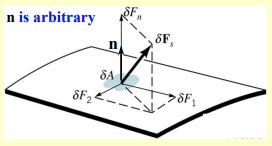Fluid Conservation of Momentum is fundamentally linked to understanding the forces acting on differential fluid elements. There are two types of forces we need to consider: body forces and surface forces.
Body Forces
Body force act throughout the volume of the fluid element. The main one is gravitational force – the weight of the fluid element due to gravity, given by
where is the mass of the element and is the gravitational acceleration.
Other examples include magnetic and electrostatic forces.
Surface Forces
Surface forces act on the surface of the fluid element. They are distributed over differential surface areas and include:
- Normal stresses – Forces perpendicular to the surface
- Shearing stresses – Forces parallel to the surface

In the above diagram we see a surface force with a normal component and shear force components and .
As the differential area approaches zero, the force per unit area defines the stresses.
Normal stress:
- Intensity of the normal force distributed over the surface area; perpendicular to the surface.
Shear stresses:
- Intensity of the parallel tangential forces; act to distort or shear the fluid element
We use double subscripts to specify the plane on which the stress acts and the direction of the stress. For example:
- → Normal stress on the x-plane in the x-direction.
- → Shear stress on the x-plane in the y-direction.

Equations of Motion
We can use the forces derived above to derive the equations of motion through control volume analysis. We consider a differential fluid element cube with dimensions .
First, we start with the surface forces in the direction.

In total, we have:
We can consider the Taylor expansions for these components. For example,
Similarly, we have
Thus, our previous expression for the total direction forces becomes
And similarly in the and directions we have
In vector form we can combine all three to have:
For body forces we have:
And the total forces are:
Applying Newton’s second law in direction gives:
This can be extended in all three directions to get equations of motion for each direction: